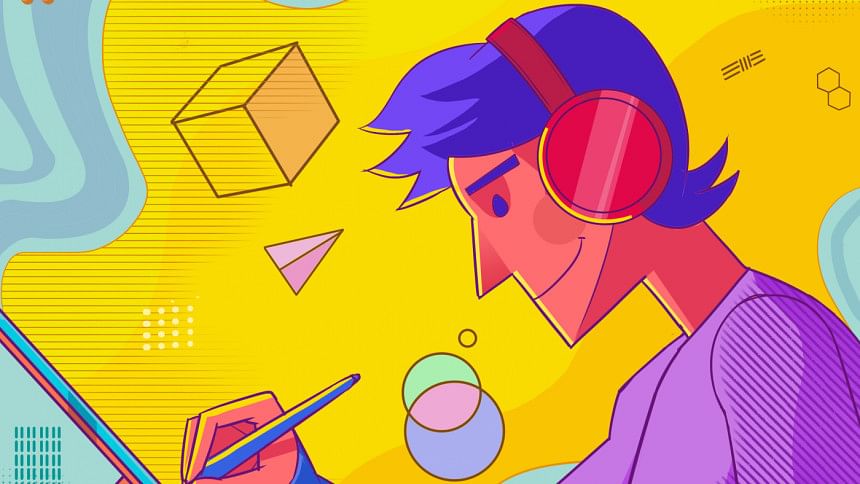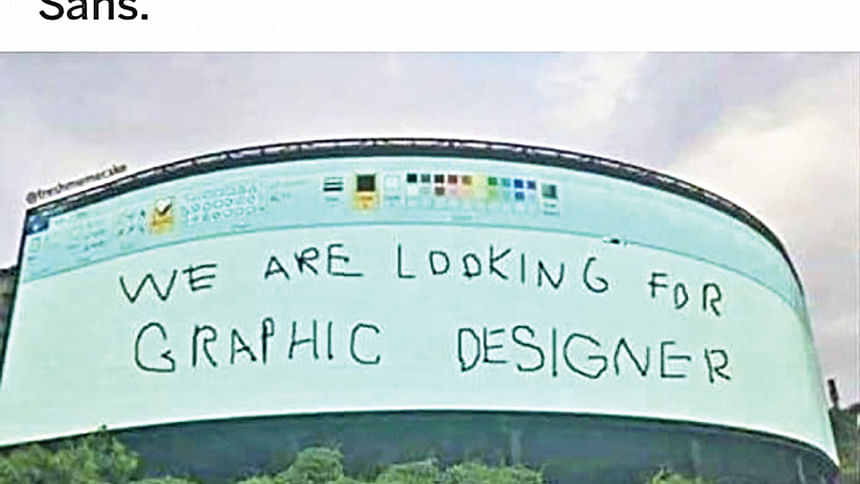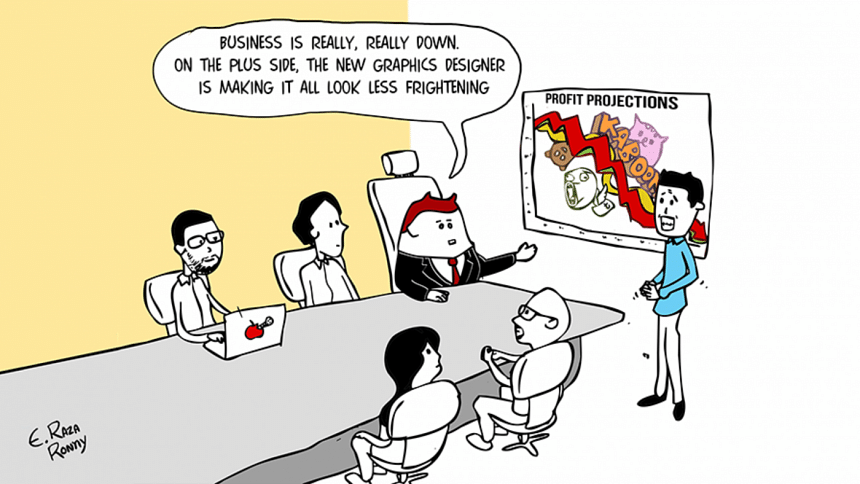Graphic Design Is My Passion.

When we hear the title "graphic designer", we immediately visualise a person frantically clicking on a mouse with their back bent towards a bright screen. Somehow, the frantic clicking produces colourful arts, logos and illustrations, and at first glance it may all look complicated.
Then the question arises, what is graphic designing? Although it's a term we hear often, most of us are unaware of what graphic designing actually is and what a job in this field really entails.
Simply put, it is a form of visual communication with the use of typography, photography, illustration, motion graphics, etc. So, your job can include making logos for small and big brands, designing user interfaces for applications or websites, making book cover designs for aspiring authors, album cover designs for your favourite artists—the list goes on.
Now that we know what it is, how do you build a career in graphic designing?
To get an idea of the basic skills required to begin your journey in this field, we spoke to Md. Harun Ar Rashid, Assistant Professor, Department of Graphic Design, Faculty of Fine Art, University of Dhaka.
"In general, most jobs in the field require some use of the various Adobe software available, and Adobe Photoshop and Adobe Illustrator are important software to master for any job in this field," he comments. Although Adobe dominates the market, there are alternatives available. CorelDRAW and Inkscape are great substitutes for Adobe Illustrator for vector art; and GIMP can be a great alternative for Adobe Photoshop for raster art. Since Adobe has a subscription fee, newcomers in this field may also be interested in the free and open-source software such as Inkscape and GIMP.
For learning, various materials are at your disposal online. YouTube can be a great platform for grasping the basics. One of our favourite channels is Gareth David Studio as this channel provides a well-rounded introduction to a lot of Adobe products. If one is interested in earning certificates, they can enrol in their desired graphic designing courses online on platforms such as Udemy and Coursera. There are also multiple books that one can find online. But, throughout the whole learning process it is just as important to continuously keep applying and honing your creative skills.

After acquiring the necessary technical skills, the next step is looking at work. Graphic designing is a vast field with opportunities almost everywhere. If you really consider it, there are few job sectors that don't require a graphic designer. Starting from ad designs for businesses to making a motion graphics video to explain science to school children, almost every field needs their help. As a result, the career opportunities are endless. It is evident that the demand for graphic designers and illustrators will always be there. The visual design industry is growing in Bangladesh, and it is safe to assume that there will be more opportunities in this field in the near future.
"I personally think that this industry will only grow bigger in the future," says Tafsir Ul Huq, a freelance graphic designer. "Brands want to make their social media presence felt, and for that, they need good visuals. Hence, they turn to agencies, or independent designers to get the job done. You could also work for newspapers, and different online media outlets. They too need good visuals to attract readers towards their content."
"In short, there will always be a need for unique and eye-catching visuals," Tafsir adds. "This in turn, will always ensure the need for graphic designers in the industry."
The most important asset at this stage is to have a diverse work portfolio. Harun Ar Rashid shares, "The first thing employers want to see when hiring a graphic designer is how good their work is. A degree or a certificate is of little use to the employer if they do not like the individual's work."
Although there are degree programs for this field, such as the ones offered by the Faculty of Fine Art in University of Dhaka, most employers judge designers on their skills and existing work and not on the certificates they have. This is one reason this field is currently attracting a lot of young designers because they realise that this is a career opportunity they can benefit from without having to pursue an academic degree. They can either take short graphic design courses in different private institutions, or learn as much as they can from the internet, before heading out in search for work or building a career in this industry.
In terms of being a good designer, Harun Ar Rashid adds, "The most important thing to keep in mind is client service. A good design will conform exactly to the clients' requests. Therefore, good communication skills are highly important. Furthermore, some technical aspects must be kept in mind to ensure a clean and crisp production of the design. Aesthetics of the design is definitely important but even if a design is aesthetically pleasing but has a lot of technical issues, it will automatically be rendered a bad design."
Now, as a graphic designer, you have the option to work full-time as well as a freelancer. Each has its own benefits and concerns. The choice will be yours to make.
"With freelancing, you get to work on your own accord, but you don't face many challenges which can deter self-development in some sense," says Harun Ar Rashid. "As a full-time graphic designer, you get to work beside other designers and so you develop and gain more experience in the field."
Tafsir made the huge decision of quitting his full-time job as a graphic designer to focus solely on a freelancing career. He was motivated by the benefits of freelancing, and was ready to take a few risks.
"I moved to freelancing once I realised that it was more profitable for me," Tafsir explains. "The pay is good, and I'm really enjoying the freedom I have right now. Of course, there's the concern that I might not always have a project to work on, but I've decided to take the risk, and thankfully, it's bringing me good results."
"Life as a graphic designer in a digital agency is quite hard," he adds. "And you don't always work 9 to 5. The work rate varies, and sadly the pay isn't that good in most of our local full-time graphic design jobs."
"Freelancing isn't easy either," claims Tafsir. "If you're looking to work as a freelancer for the rest of your life, you need to work extra hard. You'll also have to struggle a lot at the beginning. Finding clients or projects will be very difficult for newcomers. However, if you're patient and have a good work ethic, you'll find a way sooner or later."
There's no doubt that the opportunities are endless in the design industry, but that doesn't mean success will come to you if you sit idle instead of working hard for it.

"A common trait among new artists or graphic designers is the idea that they're going to get work right from the start," says Junaid Iqbal Ishmam, freelance cartoonist and illustrator, and In-Charge of Operations at Cartoon People. "However, that's not entirely certain. They'll have to fight for their place in the industry, which is already very competitive."
"As a visual artist or designer, your primary concern should be self-development," Ishmam asserts. "Practice a lot, and study the work of others. Once you've mastered the skills, and have a good portfolio that you can show, you don't have to look for work or clients. They'll come looking for you."
For some people, graphic design is something that starts out as a hobby and ends up becoming a profession. In such cases, it's very important to draw the line between the two.
Tafsir explains that when designing as a hobby, one doesn't really need to work on the advice or suggestions of others. "You can take opinions as they come and go. But as a professional, you can never do that. You need to take criticism seriously, and work on it. There will be times when you need to revise a design over and over again, just to get it in accordance to the client's specifications and needs. If you're not good at incorporating suggestions, or working with constructive criticism, you can never really succeed."
At the end of the day, working as graphic or visual designer seems like a pretty good career choice. For many people, it's a passion for creativity turned into a profession; to start graphic designing as a hobby, and ultimately stick with it for a living. That being said, like all other professions, you'll probably have to deal with a lot of failures along the way before you can actually become an expert of your work. That's all part of the process, and whether you like it or not, you'll need to face it head on before you can fully grow as a successful graphic designer.
Tasnim Odrika has only one personality trait and that is cats. Share ideas for new personality traits with her at [email protected]
Faisal wants to be the very best, like no one ever was. To stay home is his real test, to survive the pandemic is the cause. Write to him at [email protected]

 For all latest news, follow The Daily Star's Google News channel.
For all latest news, follow The Daily Star's Google News channel. 



Comments